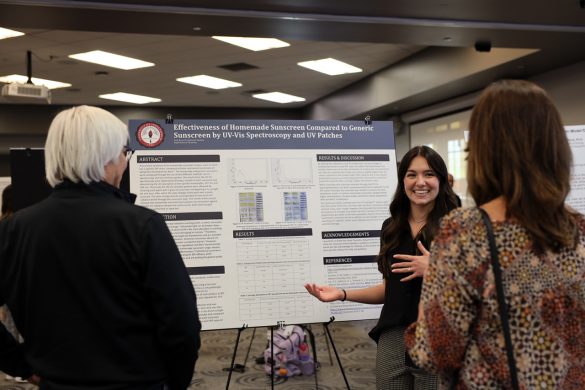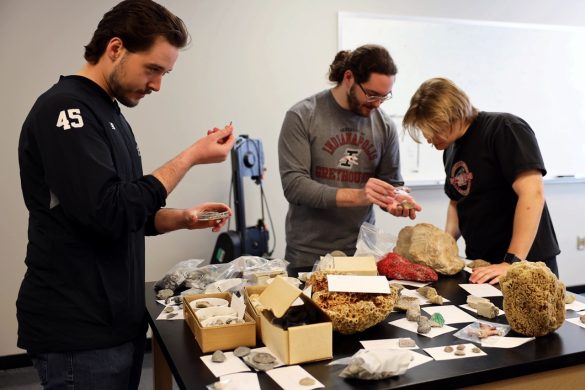Valentine’s Day has become one of the most popular and commercially targeted holidays in the United States over the past century, along with holidays such as Christmas, Thanksgiving and St. Patrick’s Day. Unlike these other holidays, though, Valentine’s Day’s origins and purpose seem muddled.
Of course, in modern society, Valentine’s Day is supposed to be a celebration of romantic love between two people, and children often celebrate the holiday by handing out cards and candy to friends and classmates. But the origin of St. Valentine and Valentine’s Day, like many other holidays, dates back to the early stages of Christianity.
In early Christian history, many who practiced the religion were persecuted by the Roman Empire for their lack of faithfulness to the Roman pantheon of gods. The origins of Valentine’s Day begin in this era (around 300 C.E.), according to Interim Executive Director of the Ron and Laura Strain Honors College and Associate Professor of History Jim Williams. Williams said that there were several people in that era who were known as Valentine and supposedly martyred in the Christian faith.
“Most martyrs are recognized or valued because they continued to profess their faith and maintain a hold of their Christianity despite the fact that the Roman government would essentially single them [out and] ask them to recognize the Roman gods. And if they refused, they would be killed in that case,” Williams said. “There is that example of Christianity that is supposed to set a guiding light for all Christians to be so true to their faith that they would be willing to die in order to show their faithfulness to God.”
When the Catholic Church became the dominant religious force within the Roman Empire, it replaced all of the old pagan holidays and festivals with those pertaining to Christianity. According to history.com, the pre-Catholic Church Roman Empire celebrated Lupercalia on Feb. 15; the holiday specifically celebrated fertility and was dedicated to one of the agricultural gods, Faunus, along with the founders of Rome, Remus and Romulus. This holiday, later replaced by the Catholic Church and moved to Feb. 14, originally celebrated Christian martyrdom.
However, even though St. Valentine’s Day remains a part of the Catholic tradition, the several people known as Valentine were removed from the list of saints within the church because of lack of evidence and documentation, according to Williams.
“Of the St. Valentines, a couple of them seemed to be in the area around Rome and martyred for one reason or another because of their Christianity,” Williams said. “But the legends or stories may or may not even be accurate because all of those [legends] come from a much later period.”
According to Williams, Valentine’s Day did not begin to have any association with love until the Middle Ages. During that time, literate people – mostly royalty and nobility, – often would write love letters to those they felt attracted to.
“Obviously, what has happened in the modern day [with Valentine’s Day] is its own thing,” Williams said. “When people celebrate Valentine’s Day, today they aren’t celebrating an example of Christian martyrdom. It would be remarkable if they even said ‘saint’ when referring to Valentine’s Day itself.”
The modern practices of Valentine’s Day have become much different from those in the Middle Ages when the element of love was first introduced into the holiday. Much of what is associated with Valentine’s Day today has to do with material possessions and commercialization and how those relate to love.
According to Associate Professor of Sociology and Criminal Justice Amanda Miller, the idea of how Valentine’s Day is supposed to be celebrated has been popularized by things such as advertising and entertainment media.
“There is a message that we get through advertisement and through watching television shows and romantic comedies that there is a certain pattern that is supposed to be followed, or a script for what Valentine’s Day is supposed to look like,” Miller said. “It’s been a very popular script, because in part the messaging draws on emotion, saying that if you don’t follow the script, then you somehow don’t love your partner.”
According to Miller, Valentine’s Day is just one of several systems put into place that commercialize romantic relationships in modern society.
“I think there is a pressure to do something grand, when in reality that might not be the most romantic thing to do,” Miller said. “We’ve seen this rise up in other ways, too. First there was the marriage proposal, then there came the ‘prom-posal.’ I think there is that same pressure with Valentine’s Day, that if you don’t do or say the right things, or it’s not a big enough gesture, that you’ve somehow doomed the relationship.”
Miller points out that not only has the focus of Valentine’s Day changed from the early Christian era and the Middle Ages, but even from as early as the 1920s through the 1940s.
“Valentine’s Day now is more about the one-on-one love relationship, versus a wider appeal where adults, too, would be able to express their fondness for their friends,” Miller said. “There was this weird tradition in the 20s, 30s and 40s called ‘Vinegar Valentine’s,’ where not only could you send a Valentine’s card to the persons that you were romantically interested in, but you also sent them to the person you hate. It was a way of societal shunning to say, essentially, ‘you are doing the wrong things; you need to back off a little bit.’”
Miller said that on a person-to-person basis, people generally feel that grand, romantic gestures and lavish spending are not necessary to celebrate Valentine ’s Day and appreciate their romantic partners, but that expectations have been established by the culture that contradict that.
“I think it [Valentine’s Day] reflects society in a way where not just time, but [also] money, is an equivalent to love,” Miller said. “I don’t think most individuals actually feel that, but I do think that it’s the messaging or branding that’s set for the holiday.”








